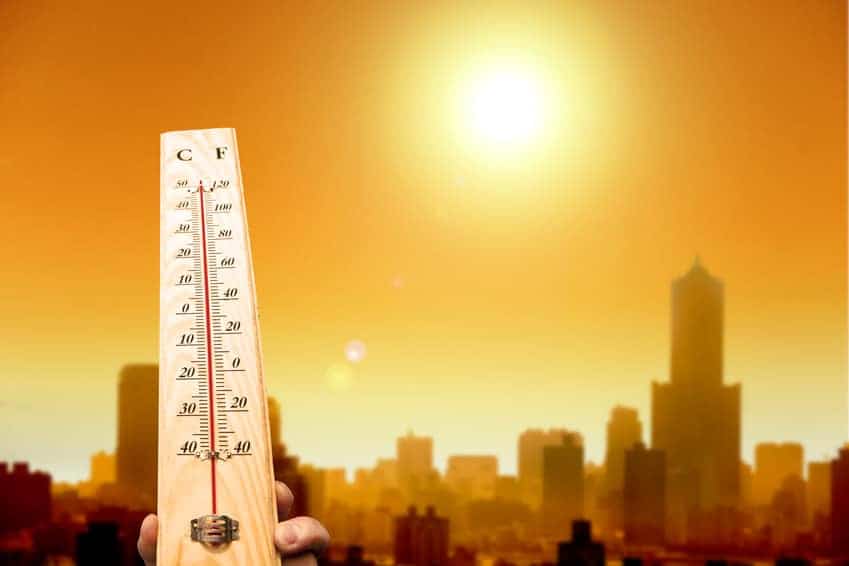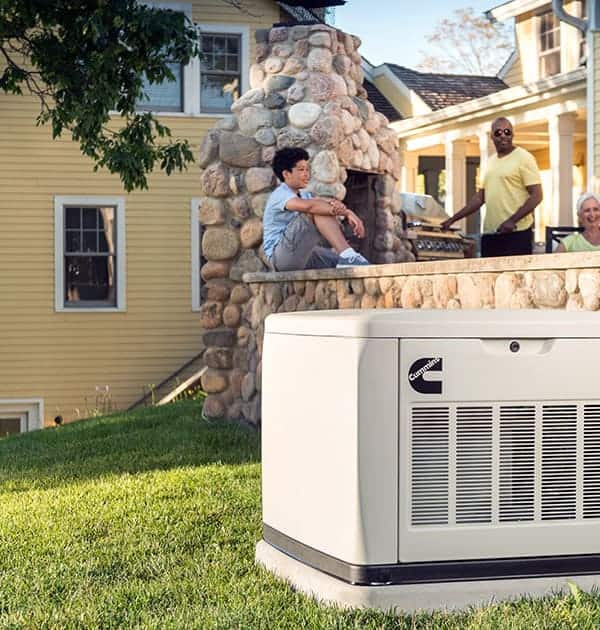Record high temperatures across the southwestern United States have residents scrambling to keep cool while power outages only add to the misery. In the San Francisco Bay Area, nine cities topped previous records. San Rafael’s 105-degree high broke the previous 98-degree record. Oakland International broke the 1962 record of 93 degrees with a 97-degree high. San Jose topped out at 103, breaking the previous record by four degrees. National Weather Service Meteorologist Anna Schneider said that more broken records are possible before the weekend.
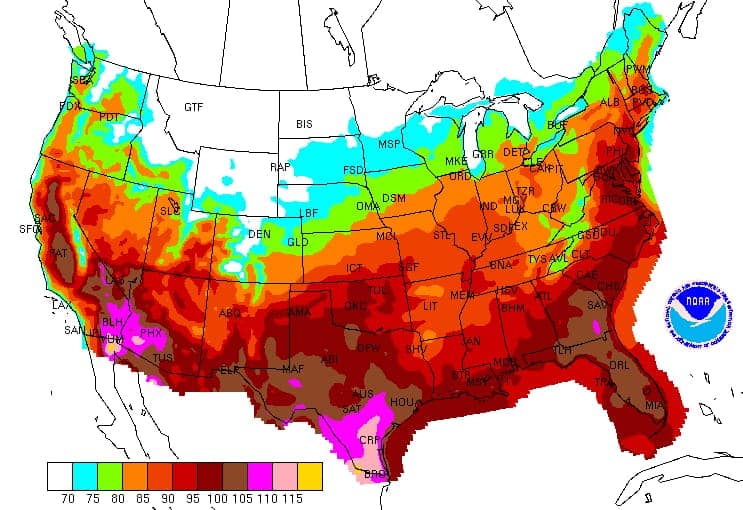
Forecast Heat Index for June 24, 2017
While the Bay Area was setting records, temperatures rose even higher in other areas. Lake Havasau City, Arizona saw 122 degrees on Father’s Day. Air conditioners were unable to keep up with the heat and ran constantly without stopping. Phoenix broke the previous record of 116 degrees in 2016 with 118 degrees on June 19, 2017. Grand Junction, Colorado saw a record high in 1940 of 101 degrees, but will top out the first day of summer with high temperature of 104. Las Vegas will fall short of previous records and reach just 116 degrees through the middle of the week.
As the heat wave sets records, electric utilities are taking measures to ensure everyone has the power they need to keep their homes cool. Heat related outages are usually the result of electrical equipment that requires maintenance. A number of maintenance outages planned for the summer were canceled, but some critical maintenance outages will still occur because without them, the equipment will fail and leave residents without cooling anyway. Accidents, weather, and other factors will continue to cause outages.
Hot Weather Safety
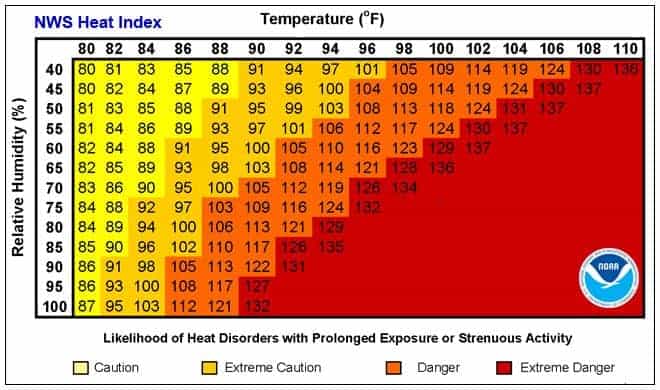
Much like the wind chill factor can make it feel much colder than the actual temperature, the Heat Index is a combination of heat and humidity that makes it feel much hotter. High humidity reduces the body’s ability to cool itself because sweat does not evaporate as easily. The heat index temperature affects the body as if it were the actual temperature.
Factor in the heat index when planning outdoor activities and work.
The Homeland Security website Ready.gov provides some key safety tips for extreme heat. They also provide the FEMA APP for heat advisories and safety tips.
- Temperatures in vehicles, even with the window cracked open, can rise to dangerous levels. Never leave children or pets alone in vehicles.
- Drink plenty of water even when you don’t feel thirsty.
- Check on family and friends who don’t have air conditioning and are alone, especially the elderly and those with disabilities.
- Keep an eye on animals to ensure they don’t suffer during the heat
- If your home loses power, go to a shelter. Text SHELTER + your Zip Code to 43362 (4FEMA) for shelter in your area.
- People without air conditioning should stay on the lowest floor out of the sun. Spend the hottest part of the day at public buildings—libraries, theaters, malls, museums, and other public facilities.
- Schedule outdoor workouts, games, and activities for the cooler parts of the day.
- Use the hashtags #HeatSafety #BeatTheHeat #SummerSafety #HeatstrokeKills to share and search on social media for extreme heat related information.
Visit Extreme at Heat Ready.gov for more tips and information.
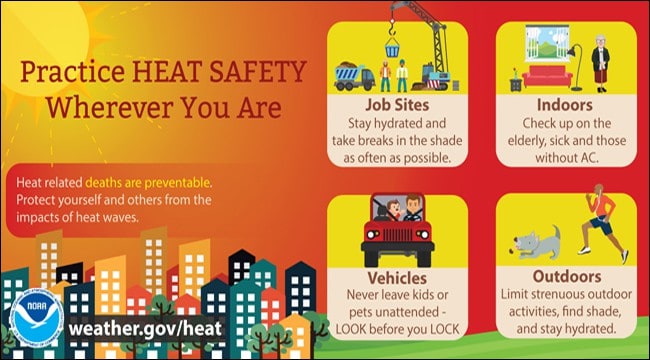
Heat Related Illness
It’s important to know the signs of heat related illnesses and prevent them from occurring.
Heat Cramps are muscle pains caused by exertion. The least severe of heat-related illness, they are the first warning that more severe trouble is on the horizon. Stop exertion. Hydrate by drinking plenty of water and electrolytes. Move to a cool location out of the sun.
Heat Exhaustion is a form of shock that will progress if the condition is not treated. It happens when body fluids are lost through heavy sweating, typically when the body is working hard in a hot, humid place. The skin may flush when blood flow is increased to the skin and reduced to the internal organs in an effort to lower the body’s temperature. Other symptoms include nausea, weakness, thirst, dizziness, headache, irritability.
Stop exercise. Drink fluids and electrolytes. Stay out of the sun and move to a cool location. Call for emergency medical treatment if a victim is unconscious, confused, or dizzy. Have them lie down and put their feet up. Only give them fluids if they are awake and not confused, dizzy, or vomiting. Turn vomiting persons on their side.
Heat Stroke is a complete loss of the body’s ability to cool itself. The victim no longer sweats and body temperature rises to the point where brain damage or even death is possible if the body is not cooled. Sun Stroke is another name for Heat Stroke. Body temperature rises above 105 degrees F.
Emergency medical attention is imperative for victims of heat stroke. Remove heavy or restrictive clothing. Move them to a cool location. Being cooling their body with cold compresses to the head, neck, and groin. Immersion in cool water is effective, but may require several people and the victim should not be left alone. Do not leave an unconscious person unattended in the water.
Prepare Your Home for Extreme Heat
Your home is probably the primary place of shelter for you and your family. It’s where you go to stay safe during extreme weather. A home that is prepared for hot weather can mean the difference between staying comfortable or worrying about heatstroke and heat exhaustion.
If you don’t have air conditioning, install window air conditioners appropriate for the rooms they will cool. Insulate and seal any openings around the air conditioners with foam insulation and weather stripping. Those with central air conditioning should ensure that ducts are properly insulated.
Cover window interiors with reflective barriers. Cardboard or foam poster boards covered with aluminum foil will reflect the heat and keep it from entering the home. After the reflectors are installed, close the drapes and shades or other window coverings to further insulate from heat. Add weather stripping to doors and windows to keep cool air in and hot air out.
Add outdoor awnings to windows that receive direct sunlight. Awnings can substantially reduce heat by up to 80 percent.
Ensure a supply of electrical power to keep your home cool and safe. A standby generator will power your central air conditioner and furnace along with refrigerators and freezers. During wet weather, they keep sump pumps running and the lights on.
Related: Best Home Standby Generators for Hot Climates
In hot climates, a liquid-cooled generator will operate more reliably than an air-cooled model. Where temperatures are more moderate and extremes less common, air-cooled standby generators operate efficiently and reliably.
Other Resources
National Integrated Heat Health Information System
Centers for Disease Control and Prevention

